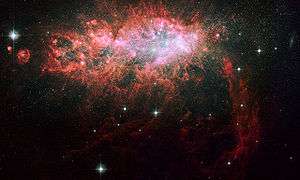Starburst region

In astronomy, starburst is a generic term to describe a region of space with an abnormally high rate of star formation.
For example, a very young open cluster can have fairly high star formation rates in its core, but this is an ordinary condition for this object. However, an entire galaxy experiencing the same star formation rate is described as "starburst".
Stars form in dense clouds of dust and gas, with there being some regions that produce an abundance of stars and some that will produce a smaller amount. In distant galaxies where there is a high production of stars, this is where the name starburst is used. [1]
Work presented in 2002 by Antony Stark and Chris Martin mapping the gas density in a 400 light year region around the Milky Way's galactic center has revealed an accumulating ring with a mass several million times that of the Sun and near the critical density for star formation. They predict that in approximately 200 million years there will be an episode of starburst in the galactic center, with many stars forming rapidly and undergoing supernovae at a hundred times the current rate. The starburst may also be accompanied by the formation of galactic jets as matter falls into the central black hole. It is thought that the Milky Way undergoes a starburst of this sort every 500 million years.
References
- ↑ "NGC 6334 - A Mini Starburst Region | Department of Physics & Astronomy". www.physastro.iastate.edu. Retrieved 2016-10-10.